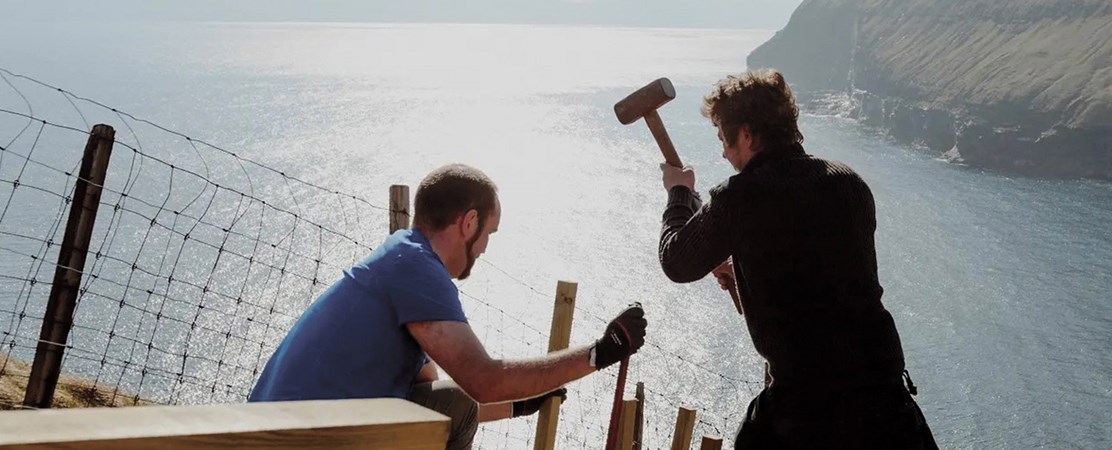Voluntourism in the Faroe Islands

By Jonathan Wood, LLM Candidate in Polar Law, MA Candidate in West Nordic Studies, University of Akureyri
How I wish that somewhere there existed an island for those who are wise and of good will.
- Albert Einstein
It appears that the Faroe Islands are attempting to make Einstein’s dream a reality. Within 24 hours of the registration opening for the 2020 “Closed for Maintenance, Open for Voluntourism” initiative, 5,886 voluntourists applied to help regrow the natural environment of the Faroe Islands through a series of distinct projects.
With only 100 slots initially opened by the Faroese Government, the process is more selective than being accepted into some of the most prestigious universities. Despite its success in 2019 with around 2,500 applications, an increase of over 2,000 applicants is extraordinary for the North Atlantic archipelago with a population hovering just above 50,000. Applications came from 95 different countries, from volunteers as young as 18 to as old as 77 with a diverse range of occupations – accountants, architects, lawyers, horse-riding coaches, diplomats, film directors. Yet they all applied with one common goal: to help maintain and preserve the Faroe Islands’ beautiful landscapes and precious natural environment.
Fourteen projects all around the archipelago were to take place this spring, but due to COVID-19 have now been postponed to 2021. They include signpost erection and cairn restoration on the old village path leading from the village of Vatnsoyrar to Mið and Sandavágur to finish a 2019 project; and completing a proper hiking path to the top of Klakkur, one of the tallest mountains surrounding Klaksvík, the second-largest town in the Faroe Islands.
The synergy between the good will of the volunteers and the Faroese Government has led both parties to find a mutually beneficial arrangement: the voluntourists get a unique experience and sense of accomplishment, while the Faroe Islands are made more accessible and promote sustainable tourism. Yet good will was only one part of Einstein’s dream island as he also wished for wisdom. The Faroese Government’s “Closed for Maintenance” program has shown that wisdom. Not only do they make the Faroe Islands an even more unique destination by limiting the number of spots – therefore increasing media attention – but they are also making the necessary infrastructure improvements for long-term sustainable tourism at a low cost by seeking volunteers.
Sustainable tourism and overtourism have become buzzwords in recent years regarding the Nordic countries, especially Iceland. The necessity to protect fragile Arctic and sub-Arctic environments while heavily relying on tourism as an industry have started to conflict. While I do not believe Iceland could enact such a plan wholesale, or that it would be an economically feasible idea for a larger country, countries should look to this initiative on the smaller scale: take some of the most at-risk tourist locales and have the infrastructure and nature restored through similar volunteer initiatives. Not only have the Faroese Islands given the voluntourists a once-in-a-lifetime experience, the news coverage the Faroes have received in doing so sets them up to increase tourism revenue when the projects are completed and they can handle the influx of regular tourists. In a sense, the Faroe Islands have adopted the precautionary principle, a tenet of international law, and applied it to their tourism industry: if there is a strong suspicion that a certain activity may have environmentally harmful consequences, it is better to control that activity now rather than wait for incontrovertible scientific evidence. Such forward thinking sets the Faroe Islands up well in the long run as a tourist destination.
One place that could adopt this model is Greenland. With a similarly sized population and lack of infrastructure in many areas, Greenland is looking to diversify its economy from extractive resources to include more tourism. As Kjellfrid Totland Hesthamar noted in their thesis, “Iceland’s experience from the rapid development of tourism the last decade can serve as an inspiration for nations who seeks growth in tourism in general, and for Greenland in particular, as they look towards Iceland when developing their tourism industry. The lessons learned from Iceland can support Greenland with initiating preventive measures in order to avoid meeting the same challenges as Iceland when developing their tourism industry.” In addition to looking at Iceland as a model for sustainable tourism, Greenland and other Arctic communities who are looking to bolster their tourism should also consider the precautionary model as shown by the Faroese.
With their creative wisdom and the good will of eco-tourists as capital, the Faroe Islands have successfully created a series of islands that would make Albert Einstein proud.
